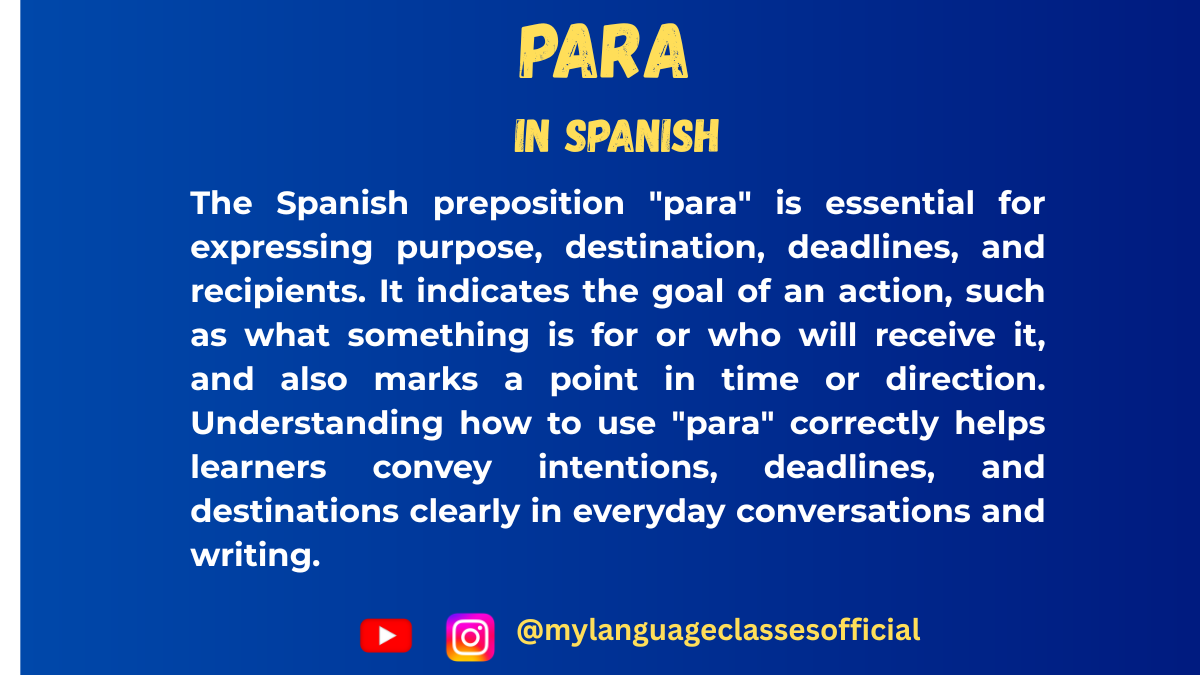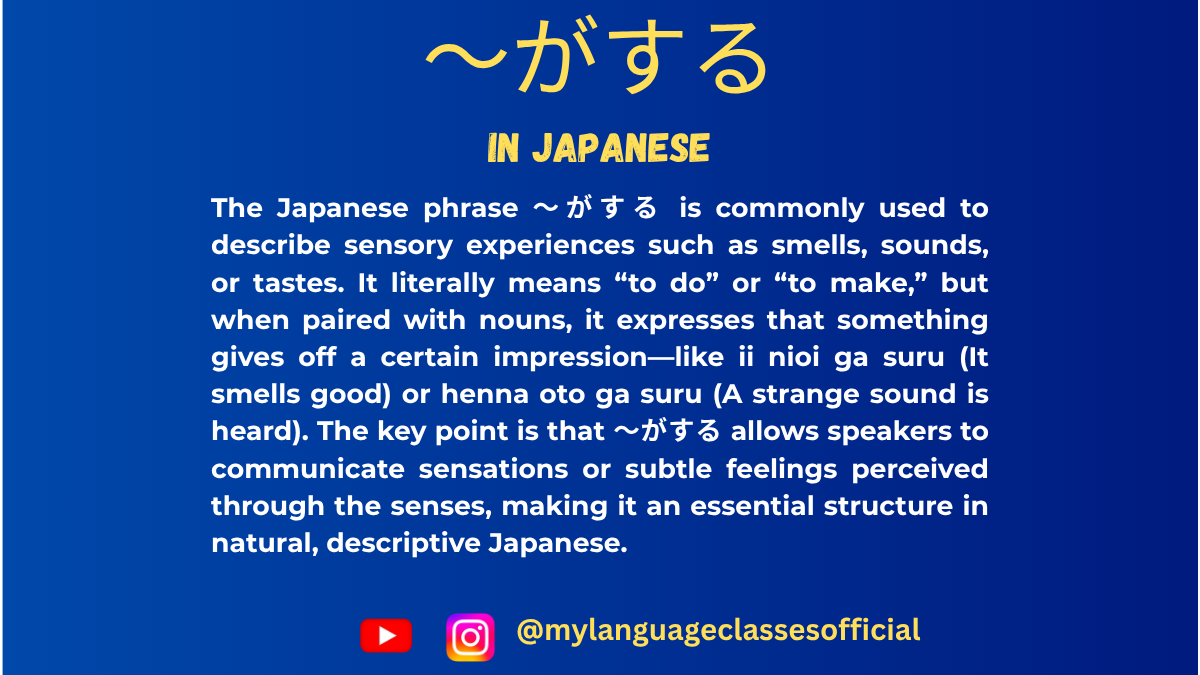Your cart is currently empty!
Tag: thing
-

Everything You Need to Know About PARA in Spanish
When learning Spanish, one of the trickiest aspects is understanding the difference between “por” and “para.” While both can translate to “for” in English, they serve different purposes in Spanish. This article will focus on “para”—its uses, common expressions, and grammatical rules.
Uses of PARA in Spanish
“Para” is generally used to indicate purpose, destination, deadlines, recipients, and opinions. Below is a detailed explanation of its main uses:
Usage Explanation Example Sentence Purpose (In order to) Used to indicate the reason for doing something. Often translates to “in order to” in English. Estudio español para hablar con fluidez. (I study Spanish in order to speak fluently.) Recipient (For someone) Used when something is intended for a person or entity. Este regalo es para ti. (This gift is for you.) Destination (Towards a place) Indicates movement towards a destination. Salimos para Madrid mañana. (We are leaving for Madrid tomorrow.) Deadline (By, For a time limit) Used to indicate a deadline for an action. La tarea es para mañana. (The homework is for tomorrow.) Employment (To work for someone) Indicates employment or who you work for. Trabajo para una empresa grande. (I work for a big company.) Comparison (Considering that) Used when making a comparison or contrast. Para un niño de 5 años, él es muy alto. (For a five-year-old, he is very tall.) Opinion (According to someone) Used to express personal opinions. Para mí, este restaurante es el mejor. (For me, this restaurant is the best.) Use (For a specific use) Used when indicating the purpose of an object. Necesito un cepillo para el pelo. (I need a brush for my hair.)
Common Expressions with PARA
Below is a list of commonly used phrases and idioms with para in daily Spanish:
Expression Meaning Example Sentence Estar para + infinitive To be about to do something Estoy para salir. (I am about to leave.) Para siempre Forever Te amaré para siempre. (I will love you forever.) Para nada Not at all No me gusta el café para nada. (I don’t like coffee at all.) Para variar Just for a change Hoy vamos a la playa para variar. (Today we are going to the beach just for a change.) No es para tanto It’s not a big deal No llores, no es para tanto. (Don’t cry, it’s not a big deal.) Para colmo To top it all off Perdimos el tren y, para colmo, empezó a llover. (We missed the train, and to top it all off, it started raining.) Para que (+ subjunctive) So that Estudia mucho para que pases el examen. (Study hard so that you pass the exam.) Ser tal para cual To be two of a kind Juan y Ana son tal para cual. (Juan and Ana are two of a kind.)
Important Grammar Rules When Using PARA
1. Articles with PARA
- When using para before a noun, it may require a definite or indefinite article (el, la, los, las, un, una, unos, unas).
- Example: Este libro es para el profesor. (This book is for the teacher.)
2. Singular vs. Plural Forms
- “Para” itself does not change with gender or number, but the words following it do.
- Example: Las flores son para las madres. (The flowers are for the mothers.)
3. Using PARA with Pronouns
- Personal pronouns with “para”: para mí, para ti, para él/ella, para nosotros, para ellos.
- Example: Este mensaje es para ti. (This message is for you.)
4. PARA vs. POR
Since “por” and “para” both mean “for” in English, beginners often confuse them. Here’s a simple trick:
- Use PARA when there’s a destination or purpose. (Voy para Madrid.)
- Use POR when there’s a cause or reason. (Voy por el trabajo.)
Things to Keep in Mind When Using PARA
- If you are expressing a purpose (“in order to”), always use the infinitive verb form after “para.”
✅ Vine para aprender español. (I came to learn Spanish.)
❌ Vine para aprendo español. (Incorrect) - “Para” is not used when talking about duration—use “por” instead.
✅ Estudié por dos horas. (I studied for two hours.)
❌ Estudié para dos horas. (Incorrect) - In spoken Spanish, native speakers often use “para” with shortened forms like “pa’” in informal speech.
Example: Voy pa’ la casa. (I’m going home.) (Casual speech)
Final Thoughts
Understanding para is crucial for mastering Spanish. By learning its different uses and practicing with common expressions, you’ll improve both comprehension and fluency. Try to use para in your daily conversations, and pay attention to how native speakers use it!
If you enjoyed this lesson, be sure to check out more posts like this on my blog at My Language Classes. Don’t forget to subscribe my YouTube channel and follow me on Instagram for the latest language learning tips and lessons. Leave a comment below to share your thoughts, or ask any questions you have.
Happy learning! 😊
-

Understanding 〜がする in Japanese | My Language Classes
Understanding the Usage of 〜がする in Japanese
The expression 〜がする is a common grammatical structure in Japanese used to describe perceptions and sensations related to the five senses, as well as intuitive feelings. It is often translated as “to smell,” “to taste,” “to feel,” or “to sound like.” This phrase allows the speaker to express their sensory or emotional experience in a natural way.
Basic Structure of 〜がする
The pattern generally follows this structure:
[Noun] + がする
Here, [Noun] represents something perceived through the senses (such as smell, taste, sound, or feeling). The verb する indicates that the sensation exists.
Situations Where 〜がする is Used
Below are the different contexts where 〜がする is commonly used:
1. Smell (Odor-related Perception)
Used when describing a smell that one perceives.
- 変なにおいがする。 (Henna nioi ga suru.) – “There is a strange smell.”
- 花の香りがする。 (Hana no kaori ga suru.) – “I smell the fragrance of flowers.”
- ガスのにおいがする。 (Gasu no nioi ga suru.) – “It smells like gas.”
2. Taste (Flavor-related Perception)
Used when describing the taste of something.
- 変な味がする。 (Henna aji ga suru.) – “It has a strange taste.”
- この水は鉄の味がする。 (Kono mizu wa tetsu no aji ga suru.) – “This water tastes like iron.”
- 甘い味がする。 (Amai aji ga suru.) – “It tastes sweet.”
3. Sound (Auditory Perception)
Used when describing a sound that one hears.
- ドアの開く音がする。 (Doa no hiraku oto ga suru.) – “I hear the sound of a door opening.”
- 雷の音がする。 (Kaminari no oto ga suru.) – “I hear the sound of thunder.”
- 人の話し声がする。 (Hito no hanashigoe ga suru.) – “I hear people’s voices.”
4. Feeling (Emotional or Intuitive Perception)
Used when describing a feeling, intuition, or an atmosphere.
- 嫌な感じがする。 (Iyana kanji ga suru.) – “I have a bad feeling.”
- 胸騒ぎがする。 (Munasawagi ga suru.) – “I have a premonition (of something bad).”
- ワクワクする感じがする。 (Wakuwaku suru kanji ga suru.) – “I have an exciting feeling.”
5. Physical Sensations (Pain or Bodily Feelings)
Used when describing physical sensations or discomfort.
- 頭が痛い感じがする。 (Atama ga itai kanji ga suru.) – “I feel like I have a headache.”
- 吐き気がする。 (Hakike ga suru.) – “I feel nauseous.”
- 寒気がする。 (Samuke ga suru.) – “I feel chills.”
6. Other Abstract Feelings and Situations
It can be used to describe abstract or indirect experiences.
- あの人は信用できない気がする。 (Ano hito wa shinyou dekinai ki ga suru.) – “I feel like that person is untrustworthy.”
- ここは何か違う感じがする。 (Koko wa nanika chigau kanji ga suru.) – “This place feels different.”
Key Points to Remember
- 〜がする is used to describe sensory experiences, including smell, taste, sound, and physical or emotional feelings.
- It is typically used with nouns related to perception, such as におい (smell), 味 (taste), 音 (sound), 気 (feeling), 感じ (sensation), 痛み (pain), etc.
- It can be used for both literal (real sensory perceptions) and abstract (intuition, atmosphere, emotions) experiences.
- The phrase makes statements subjective, meaning it expresses the speaker’s personal perception rather than an objective fact.
Conclusion
Understanding 〜がする is essential for expressing sensory perceptions naturally in Japanese. Whether you’re describing a delicious meal, a strange smell, an ominous feeling, or an unexpected noise, this structure is an invaluable tool in communication. Mastering its usage will enhance your ability to express experiences vividly and naturally in Japanese.
By practicing various sentence patterns using 〜がする, learners can deepen their understanding and fluency in Japanese conversation. Try using it in your daily observations to get more comfortable with its application!
If you enjoyed this lesson, be sure to check out more posts like this on my blog at My Language Classes. Don’t forget to subscribe my YouTube channel and follow me on Instagram for the latest language learning tips and lessons. Leave a comment below to share your thoughts, or ask any questions you have about nouns.
Happy learning! 😊
